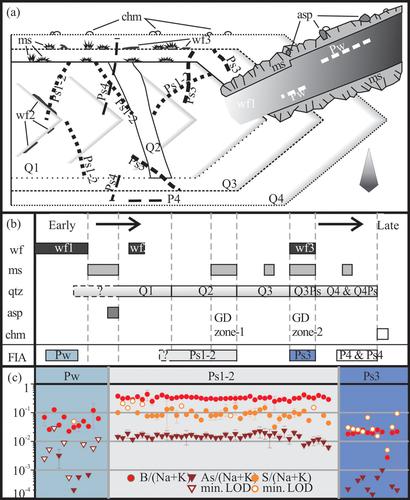当前位置:
X-MOL 学术
›
Acta Geol. Sinica Engl. Ed.
›
论文详情
Our official English website, www.x-mol.net, welcomes your
feedback! (Note: you will need to create a separate account there.)
Ore‐forming Fluid and Metallogenic Mechanism of Wolframite–Quartz Vein‐type Tungsten Deposits in South China
Acta Geologica Sinica-English Edition ( IF 3.5 ) Pub Date : 2020-12-08 , DOI: 10.1111/1755-6724.14596 Pei NI 1 , Wensheng LI 1 , Juny PAN 1
Acta Geologica Sinica-English Edition ( IF 3.5 ) Pub Date : 2020-12-08 , DOI: 10.1111/1755-6724.14596 Pei NI 1 , Wensheng LI 1 , Juny PAN 1
Affiliation

|
South China is endowed with copious wolframite–quartz vein‐type W deposits that provide a significant contribution to the world's tungsten production. Mineralization is spatially associated with highly evolved granites, which have been interpreted as products of ancient crustal anatexis. Ore veins are mainly hosted in low‐grade metamorphosed quartz sandstone, slate and granitic rocks. The ore minerals mainly comprise wolframite, cassiterite, scheelite and pyrite, with minor molybdenite, arsenopyrite and chalcopyrite. Typical steeply dipping veins can be divided into five zones from top to the bottom, namely: (I) thread, (II) veinlet, (III) moderate vein, (IV) thick vein, and (V) thin out zones. In general, three types of fluid inclusions at room temperature are commonly recognized in wolframite and/or quartz from these veins: two‐phase liquid‐rich (type L), two‐phase CO2‐bearing (type CB), and CO2‐rich (type C). Comparative microthermometry performed on fluid inclusions hosted in wolframite and associated quartz indicates that most wolframite was not co‐precipitated with the coexisting quartz. Detailed petrographic observation and cathodoluminescence (CL) imaging on coexisting wolframite and quartz of the Yaogangxian deposit, show repeated precipitation of quartz, wolframite, and muscovite, suggesting a more complex fluid process forming these veins. Previous studies of H‐O isotopes and fluid inclusions suggested that the main ore‐forming fluids forming the wolframite–quartz vein‐type deposits had a magmatic source, whereas an unresolved debate is centered on whether mantle material supplemented the ore‐forming fluids. The variable CO2 contents in the ore‐forming fluids also implies that CO2 might have had a positive effect on ore formation. Fluid inclusion studies indicate that wolframite was most likely deposited during cooling from an initial H2O + NaCl ± CO2 magmatic fluid. In addition, fluid‐phase separation and/or mixing with sedimentary fluid might also have played an important role in promoting wolframite deposition. We speculate that these processes determine the precipitation of W to varying degrees whereas the leading mechanistic cause remains an open question. Comprehensive studies on spatial variation of fluid inclusions show that both the steeply and gently dipping veins are consistent with the “five floors” model that may have broader applications to exploration of wolframite–quartz vein‐type deposits. Recent quantitative analysis of wolframite‐ and quartz‐hosted fluid inclusions by laser ablation inductively‐coupled plasma mass spectrometry shows enhanced advantages in revealing fluid evolution, tracing the fluid source and dissecting the ore precipitation process. Further studies on wolframite–quartz vein‐type W deposits to bring a deeper understanding on ore‐forming fluids and the metallogenic mechanism involved.
中文翻译:

华南钨铁-石英脉型钨矿床成矿流体及成矿机理
华南地区拥有丰富的黑钨矿-石英脉型W矿床,为世界钨的生产做出了重要贡献。矿化在空间上与高度演化的花岗岩有关,花岗岩被解释为古代地壳的产物。矿脉主要存在于低品位的变质石英砂岩,板岩和花岗岩中。矿石矿物主要包括黑钨矿,锡石,白钨矿和黄铁矿,以及少量辉钼矿,毒砂和黄铜矿。典型的陡倾静脉可以从顶部到底部分为五个区域,即:(I)螺纹,(II)小静脉,(III)中度静脉,(IV)粗静脉和(V)稀疏区域。通常,从这些脉络的黑钨矿和/或石英中通常识别出三种类型的室温流体夹杂物:2轴承(CB型)和富含CO 2(C型)。对黑钨矿和相关石英中所含流体包裹体进行的比较微量热分析表明,大多数黑钨矿并未与共存石英共沉淀。姚岗县矿床共存的黑钨矿和石英的详细岩相学观察和阴极发光(CL)成像显示,石英,黑钨矿和白云母反复沉淀,表明形成这些脉的流体过程更为复杂。以前对H-O同位素和流体包裹体的研究表明,形成黑钨矿-石英脉状沉积物的主要成矿流体具有岩浆来源,而尚未解决的争论集中在地幔物质是否补充了成矿流体上。可变CO 2成矿流体中的含量还暗示CO 2可能对成矿有积极作用。流体包裹体研究表明,黑钨矿最有可能在冷却过程中由初始H 2 O + NaCl±CO 2沉积岩浆液。此外,液相分离和/或与沉积液混合在促进黑钨矿沉积中也可能起了重要作用。我们推测这些过程在不同程度上决定了W的沉淀,而主要的机械原因仍然是一个悬而未决的问题。对流体包裹体空间变化的综合研究表明,陡峭和缓倾的矿脉均与“五层”模型一致,该模型可能在黑钨矿-石英矿脉型矿床的勘探中具有更广泛的应用。最近通过激光烧蚀电感耦合等离子体质谱法对黑钨矿和石英基流体包裹体进行的定量分析显示出在揭示流体演化,追踪流体源和剖析矿石沉淀过程方面的优势。
更新日期:2020-12-29
中文翻译:

华南钨铁-石英脉型钨矿床成矿流体及成矿机理
华南地区拥有丰富的黑钨矿-石英脉型W矿床,为世界钨的生产做出了重要贡献。矿化在空间上与高度演化的花岗岩有关,花岗岩被解释为古代地壳的产物。矿脉主要存在于低品位的变质石英砂岩,板岩和花岗岩中。矿石矿物主要包括黑钨矿,锡石,白钨矿和黄铁矿,以及少量辉钼矿,毒砂和黄铜矿。典型的陡倾静脉可以从顶部到底部分为五个区域,即:(I)螺纹,(II)小静脉,(III)中度静脉,(IV)粗静脉和(V)稀疏区域。通常,从这些脉络的黑钨矿和/或石英中通常识别出三种类型的室温流体夹杂物:2轴承(CB型)和富含CO 2(C型)。对黑钨矿和相关石英中所含流体包裹体进行的比较微量热分析表明,大多数黑钨矿并未与共存石英共沉淀。姚岗县矿床共存的黑钨矿和石英的详细岩相学观察和阴极发光(CL)成像显示,石英,黑钨矿和白云母反复沉淀,表明形成这些脉的流体过程更为复杂。以前对H-O同位素和流体包裹体的研究表明,形成黑钨矿-石英脉状沉积物的主要成矿流体具有岩浆来源,而尚未解决的争论集中在地幔物质是否补充了成矿流体上。可变CO 2成矿流体中的含量还暗示CO 2可能对成矿有积极作用。流体包裹体研究表明,黑钨矿最有可能在冷却过程中由初始H 2 O + NaCl±CO 2沉积岩浆液。此外,液相分离和/或与沉积液混合在促进黑钨矿沉积中也可能起了重要作用。我们推测这些过程在不同程度上决定了W的沉淀,而主要的机械原因仍然是一个悬而未决的问题。对流体包裹体空间变化的综合研究表明,陡峭和缓倾的矿脉均与“五层”模型一致,该模型可能在黑钨矿-石英矿脉型矿床的勘探中具有更广泛的应用。最近通过激光烧蚀电感耦合等离子体质谱法对黑钨矿和石英基流体包裹体进行的定量分析显示出在揭示流体演化,追踪流体源和剖析矿石沉淀过程方面的优势。









































 京公网安备 11010802027423号
京公网安备 11010802027423号